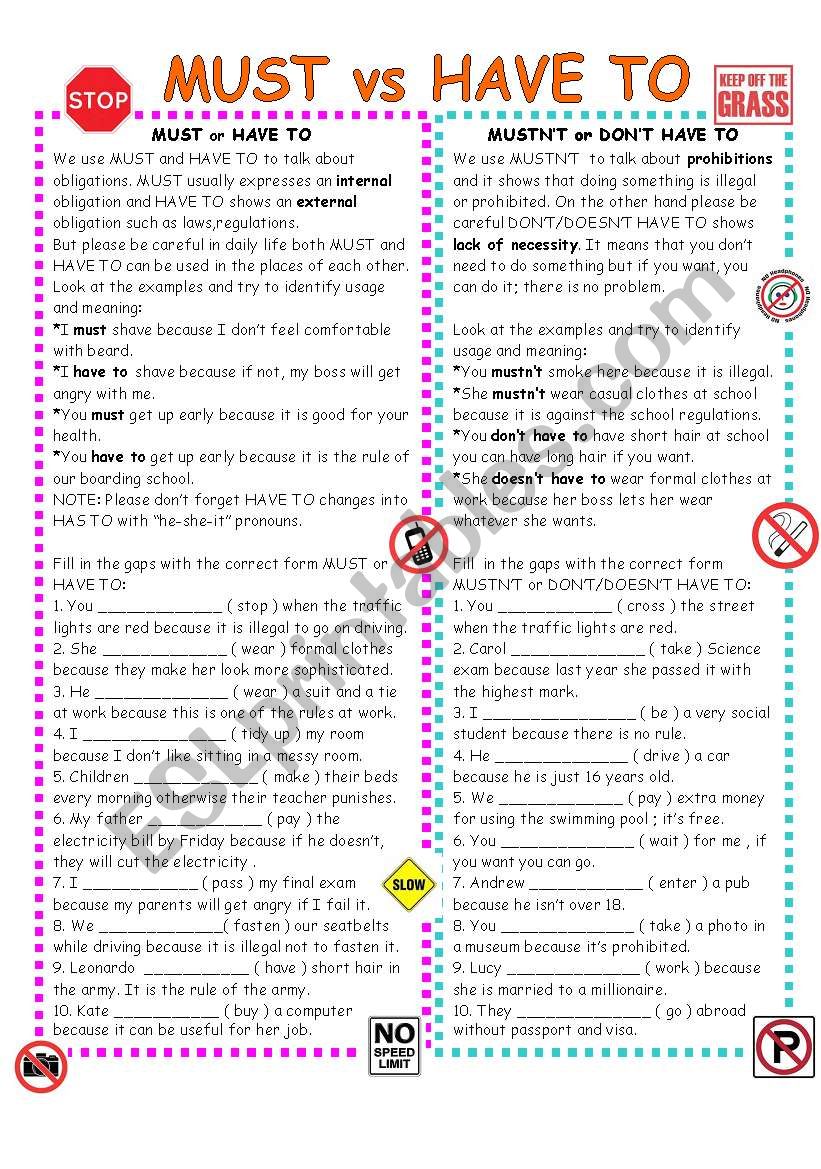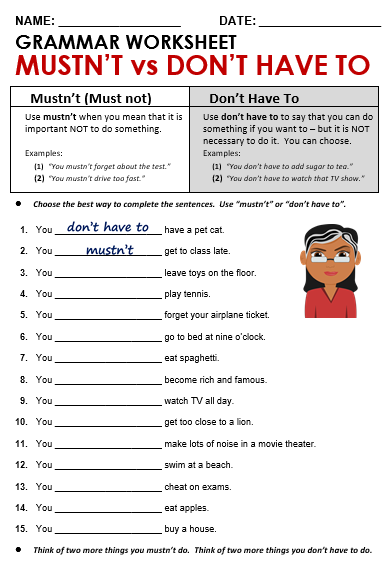
Mastering Obligation and Necessity: The Indispensable Role of Grammar Worksheets: Must/Have To
In the intricate tapestry of the English language, expressing obligation, necessity, and prohibition is fundamental to clear and effective communication. Two modal verbs that often present a nuanced challenge for learners are "must" and "have to." While both convey a sense of requirement, their subtle differences in origin, emphasis, and usage across tenses can be a source of confusion. This is precisely where well-designed Grammar Worksheets: Must/Have To become an indispensable tool, guiding learners through the complexities and cementing their understanding.
This article delves into the core distinctions between "must" and "have to," explores common pitfalls, and, most importantly, illuminates how targeted practice through Grammar Worksheets: Must/Have To can transform tentative understanding into confident mastery.

The Core Concepts: Must vs. Have To

At first glance, "must" and "have to" appear interchangeable, both signifying an action that is required. However, their fundamental difference lies in the source of the obligation.

1. Must: Internal Obligation, Strong Recommendation, and Deduction

"Must" primarily conveys an obligation that comes from the speaker’s internal conviction or a strong, often personal, sense of necessity. It reflects the speaker’s feeling or belief about what is right, important, or unavoidable.

- Internal Obligation/Personal Necessity:
- Examples:
- "I must finish this report by tonight." (The speaker feels a personal obligation.)
- "We must try to be more organized." (A strong recommendation from the speaker.)
- "You must see that new movie; it’s fantastic!" (A strong recommendation based on the speaker’s opinion.)



- Examples:
- Deduction/Logical Conclusion: "Must" can also be used to express a strong probability or a logical conclusion based on evidence.

- Examples:
- "He must be exhausted; he’s been working all day." (A logical deduction.)
- "There’s no light on. They must be out." (A logical conclusion.)
- Examples:
Key characteristics of "must":
- It is a modal verb, meaning it doesn’t change form (no "musts" or "musted").
- It is followed by the base form of the verb (infinitive without "to").
- It generally refers to present or future obligations. It does not have a past tense for obligation.
2. Have To: External Obligation, Rules, and Regulations
"Have to," on the other hand, expresses an obligation that originates from an external source. This could be a rule, a law, an instruction from an authority figure, or a circumstance that dictates an action. The speaker is simply stating a fact about a requirement imposed by outside forces.
- External Obligation/Rules/Laws:
- Examples:
- "Students have to wear a uniform." (A school rule.)
- "You have to have a passport to travel internationally." (A legal requirement.)
- "I have to work on Saturday." (An external circumstance, e.g., the boss told them to.)
- Examples:
- Circumstantial Necessity:
- Examples:
- "We have to leave now, or we’ll miss the train." (A necessity dictated by circumstances.)
- Examples:
Key characteristics of "have to":
- It is often referred to as a semi-modal verb because it behaves more like a regular verb in terms of conjugation (e.g., "he has to," "they had to") and requires "do/does/did" for questions and negatives.
- It is followed by the infinitive with "to."
- Crucially, "have to" can be used in all tenses:
- Present: "I have to study." / "She has to leave."
- Past: "I had to work late yesterday."
- Future: "I will have to attend the meeting tomorrow."
- Present Perfect: "I have had to revise my plans several times."
Expanding the Scope: Negatives and Questions – A Common Pitfall
The distinction between "must" and "have to" becomes even more critical when forming negatives and questions, as their meanings diverge significantly. This is a prime area where Grammar Worksheets: Must/Have To can provide targeted practice to prevent common errors.
1. Prohibition vs. Lack of Obligation:
- Mustn’t (Must Not): Prohibition
- "Mustn’t" expresses a strong prohibition – something that is forbidden or not allowed.
- Examples:
- "You mustn’t smoke in here." (It is forbidden.)
- "We mustn’t forget to lock the door." (It is very important not to forget.)
- Don’t Have To (Do Not Have To): Lack of Obligation
- "Don’t have to" expresses a lack of obligation or necessity – something that is not required, but you can do it if you wish. It does not mean prohibition.
- Examples:
- "You don’t have to wear a tie to the party." (It’s not necessary, but you can if you want.)
- "I don’t have to work tomorrow." (It’s not required for me to work.)
This is arguably the most common area of confusion. A student saying "You mustn’t pay" when they mean "You don’t have to pay" fundamentally alters the message from "It is forbidden to pay" to "It is not necessary to pay." Grammar Worksheets: Must/Have To often include exercises specifically designed to highlight and practice this crucial difference.
2. Forming Questions:
- Must: Questions with "must" are less common for obligation, but they can be used for strong advice or deduction.
- Examples:
- "Must I go?" (Is it absolutely necessary, in your opinion?)
- "Why must you always be late?" (Expressing frustration about a recurring action.)
- "Where must he be going?" (Deduction)
- Examples:
- Have To: Questions with "have to" use the auxiliary verbs "do," "does," or "did."
- Examples:
- "Do you have to work weekends?"
- "Does she have to wear a uniform?"
- "Did they have to leave so early?"
- Examples:
The Pedagogical Power of Grammar Worksheets: Must/Have To
Given the subtle yet significant distinctions between "must" and "have to," and their different behaviors in negative and interrogative forms, structured practice is paramount. This is where Grammar Worksheets: Must/Have To prove their immense value. They provide a controlled environment for learners to:
- Reinforce Understanding: After initial instruction, worksheets offer immediate opportunities to apply the rules learned.
- Identify and Correct Errors: By attempting various exercises, learners (and teachers) can pinpoint specific areas of misunderstanding, such as confusing
mustn'twithdon't have to. - Build Fluency and Accuracy: Repeated, targeted practice helps internalize the correct usage, leading to more natural and accurate communication.
- Promote Independent Learning: Worksheets allow learners to practice at their own pace, outside of direct classroom instruction.
- Assess Progress: Teachers can use worksheets as formative or summative assessments to gauge comprehension.
Designing Effective Grammar Worksheets: Must/Have To
An effective worksheet isn’t just a random collection of sentences. It’s a carefully crafted sequence of exercises designed to build understanding progressively. Here are key components and exercise types often found in successful Grammar Worksheets: Must/Have To:
- Clear Explanations and Examples: A good worksheet often starts with a concise review of the rules, complete with illustrative examples, especially highlighting the
must/have toandmustn't/don't have todistinctions. - Gap-Fill Exercises: These are excellent for initial controlled practice.
- Example: "You _____ (wear) a helmet when riding a motorbike. (law)" (Answer: have to wear)
- Example: "I _____ (call) my mother. It’s her birthday. (personal feeling)" (Answer: must call)
- Choose the Best Option: Presenting sentences where learners must select between "must" or "have to" (and their negatives) forces them to consider the source of the obligation.
- Example: "In our company, everyone (must / has to) attend the weekly meeting."
- Example: "You (mustn’t / don’t have to) tell anyone our secret."
- Sentence Transformation: This challenges learners to rephrase sentences using the target grammar, deepening their understanding of nuance.
- Example: "It is forbidden to park here." -> "You _____ park here." (Answer: mustn’t)
- Example: "It is not necessary for you to come early." -> "You _____ come early." (Answer: don’t have to)
- Error Correction: Providing sentences with common mistakes related to "must" and "have to" encourages critical thinking and attention to detail.
- Example: "I musted go to the dentist yesterday." (Correction: I had to go…)
- Example: "You don’t have to smoke here." (Correction depends on intent: You mustn’t smoke here if forbidden, or You don’t need to smoke here if optional.)
- Scenario-Based Exercises: Presenting short scenarios or dialogues where learners must decide which verb to use based on context.
- Example: "Your friend is feeling very unwell. What do they have to/ must do?" (Answer: must see a doctor – strong recommendation; have to go to hospital if it’s a rule/emergency protocol.)
- Open-Ended Questions/Writing Prompts: Encouraging learners to write their own sentences or short paragraphs using "must" and "have to" in meaningful contexts.
- Example: "List three things you must do before you turn 30, and three things you have to do as a student."
Integrating Worksheets into the Learning Process
Worksheets are most effective when integrated thoughtfully into a broader learning strategy:
- Pre-Work: Assigning a worksheet as homework before a lesson can help activate prior knowledge or introduce the topic.
- Guided Practice: Completing sections of a worksheet together in class, with the teacher providing support and immediate feedback.
- Independent Practice: Allowing learners to complete sections or entire worksheets on their own, reinforcing the concepts learned in class.
- Review and Correction: Always dedicating time to review answers, discuss common mistakes, and clarify any lingering confusion.
- Follow-Up Activities: Using the sentences or scenarios from the worksheet as springboards for speaking or writing activities, pushing learners beyond mere grammatical correctness to communicative competence.
Conclusion
The distinction between "must" and "have to" is a cornerstone of expressing obligation and necessity in English, reflecting whether a requirement stems from internal conviction or external circumstance. While seemingly subtle, mastering this difference is crucial for both comprehension and accurate expression.
Well-crafted Grammar Worksheets: Must/Have To are not just supplementary materials; they are central to the learning process. By offering varied, contextualized, and progressive exercises, they provide the systematic practice needed to solidify understanding, correct common errors, and ultimately empower learners to navigate the nuances of English obligation with confidence and precision. Ultimately, well-designed Grammar Worksheets: Must/Have To serve as invaluable tools, transforming abstract grammatical rules into practical, usable language skills.
